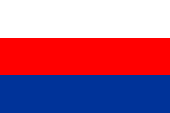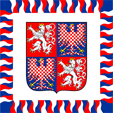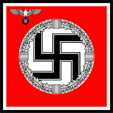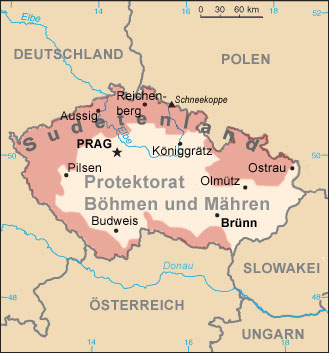Böhmen und Mähren |
|
|
|
| Übersicht – Contents: | |
Böhmen und Mähren |
|
|
|
| Übersicht – Contents: | |
Flaggen – Flags: |
|
 |
1939–1945, |
 |
1939–1945, |
 |
1939–1944, |
 |
1944–1945, |
|
|
|
Bedeutung/Ursprung der Flagge – Meaning/Origin of the Flag: |
|
| Die Flagge des Protektorats Böhmen und Mähren wurde im März 1939 eingeführt, da die angestrebte Beibehaltung der bisherigen Tschechoslowakischen Flagge durch das Deutsche Reich abgelehnt wurde. Die neue Flagge zeigte drei waagerechte Streifen in Weiß, Rot und Blau. Die Farben Weiß und Rot sind die seit dem 12. Jahrhundert bekannten böhmischen Wappenfarben (weißer Löwe auf Rot), während Blau Mähren repräsentieren sollte. | The flag
of the Protectorate of Bohemia and Moravia was introduced in March 1939,
because the striven continue of the hitherto Czechoslovakian flag was
rejected by the German Empire. The new flag showed three horizontal stripes
im white, red and blue. The colours white and red are
the since the 12th century known Bohemian colours (white lion on red), blue
should represent Moravia. |
| Quelle/Source: Flaggen und Wappen der Welt, Volker Preuß | |
Wappen – Coat of Arms: |
|
 |
1939–1945, großes Wappen des Reichsprotektorats Böhmen und Mähren – greater coat of arms of the Protectorate of Bohemia and Moravia, Quelle/Source: nach/by: Fornax / Public domain |
 |
1939–1945, kleines Wappen des Reichsprotektorats Böhmen und Mähren – lesser coat of arms of the Protectorate of Bohemia and Moravia, Quelle/Source: Bohemia_Moravia_Greater_Arms_1939-1945.svg: Fornaxderivative work: ARvєδuι + / Public domain |
Bedeutung/Ursprung des Wappens – Meaning/Origin of the Coat of Arms: |
|
| Das große Wappen des Protektorats Böhmen und Mähren zeigte ein gevierteiltes Schild, im ersten und vierten Feld das Wappen Böhmens (silberner zweischwänziger Löwe mit goldener Krone auf rotem Grund), im zweiten und dritten Feld das Wappen Mährens (silber-rot geschachter Adler mit goldener Krone auf blauem Grund). | The greater coat of arms of the Protectorate of Bohemia and Moravia showed a quartered shield, in the first and fourth field the scutcheon of Bohemia (silvery double-tailed lion with golden crown on red ground), in the second and third field the scutcheon of Moravia (silvery-red chess-board styled eagle with with golden crown on blue ground). |
| Quelle/Source: Volker Preuß | |
| Landkarte – Map: | |
|
 |
| Quelle/Source: CIA World Factbook, modyfied by: Volker Preuß | |
Zahlen und Fakten – Numbers and Facts: |
|
|
|
|
|
|
|
|
|
|
|
|
|
|
|
|
|
|
|
|
Geschichte: |
|
Geschichte Böhmens bis 1918 (hier klicken) Geschichte Mährens bis 1918 (hier klicken) 28.10.1918 ·
Gründung der Tschechoslowakei durch
den Zusammenschluss von Böhmen,
Mähren,
Österreichisch-Schlesien und der
Slowakei |
History: |
| History
of Bohemia to 1918 (→ click here) History of Moravia to 1918 (→ click here) 28th of October 1918
· formation of Czechoslovakia by
merger of Bohemia, Moravia,
Austrian Silesia and of Slovakia |
| Quelle/Source: Wikipedia (D), World Statesmen, Discovery '97, Weltgeschichte |
Ursprung des Landesnamens – Origin of the Country's Name: |
|
| "Böhmen und Mähren" ist die Zusammenfassung der Namen der beiden Landschaften, jedoch zwischen 1939 und 1945 in nicht historischen Grenzen. Die Bezeichnung "Protektorat" war unehrlich und absolut unpassend, denn ein Protektorat ist ein Schutzstaat. In Wirklichkeit war Böhmen und Mähren ein machtloses, der Willkür des nationalsozialistischen Deutschen Reiches ausgeliefertes Objekt. | "Bohemia and Moravia" is the summary of the names of those both landscapes, but between 1939 and 1945 in non-historical borders. The denomination "Protectorate" was dishonestly and absolutely improper, because a protectorate is a to shelter state. In reality was Bohemia and Moravia a powerless, to the arbitrariness of the national socialistic German Empire committed object. |
| Der Name "Böhmen" geht auf den keltischen Stamm der Bojer zurück, der hier in der Antike siedelte. Die Bojer wurden 80–70 v.Chr. von den germanischen Markomannen verdrängt. Die slawischen Tschechen besiedelten das Land im 6. Jahrhundert. Die tschechische Bezeichnung "Cesko", also "Tschechei", kam erst im 19. Jahrhundert mit den Erstarken des tschechischen Nationalismus auf. | The designation "Bohemia" has its roots in the Celtic tribe of the Boyers, which settled here in the antquity. The Boyers were pushed aside 80–70 B.C. by the Teutonic Markomans. The Slavic Czech populated the country in the 6th century. The Czech designation "Cesko" – ergo "Czechia" – arised not until the 19th century in context with the growing strong of the Czech nationalism. |
| Der Name "Mähren" ist slawischen Ursprungs und geht auf den Fluss "March" zurück, der bei Pressburg in die Donau mündet. In alten Zeiten wurde der Fluss noch "Maraha" genannt, und das Land durch welches er fließt "Marahanien". So wurden aus den Bewohnern dieses Landes "Marahanen", die später "Mähren", "Mährer" oder "Moravci" genannt wurden. Die "March" heißt in der heutigen tschechischen Landessprache "Morava", so wie der Landesname "Mähren", der in Tschechisch ebenfalls "Morava" heißt. | The designation "Moravia" is of Slavic origin and has its roots in the "March River", which flows near Pressburg in the Danube River. In ancient times that river was named "Maraha" and the land he flows through "Marahania". In this way became the residents of that land "Marahans" which were named afterward "Maehren", "Moravians" or "Moravci". The "March River" is named in the today’s Czech language "Morava", like the name of the country "Moravia" which is named in Czech language "Morava" too. |
| Quelle/Source: Handbuch der geographischen Namen, Meyers Konversationslexikon, Wikipedia (D), Volker Preuß | |